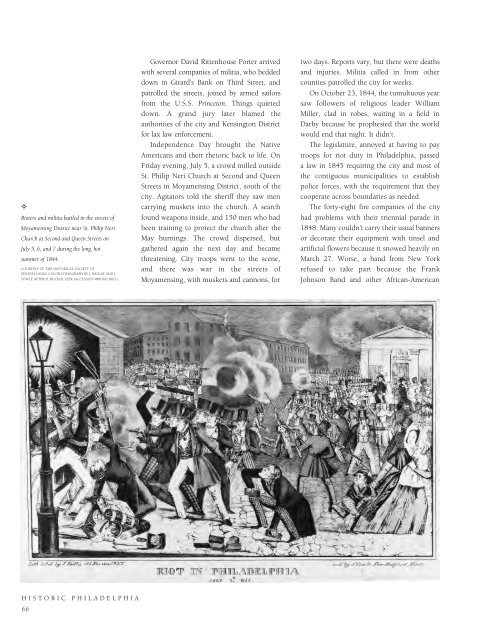Historic Philadelphia
An illustrated history of the city of Philadelphia, paired with the histories of companies, families and organizations that make the region great.
An illustrated history of the city of Philadelphia, paired with the histories of companies, families and organizations that make the region great.
You also want an ePaper? Increase the reach of your titles
YUMPU automatically turns print PDFs into web optimized ePapers that Google loves.
✧<br />
Rioters and militia battled in the streets of<br />
Moyamensing District near St. Philip Neri<br />
Church at Second and Queen Streets on<br />
July 5, 6, and 7 during the long, hot<br />
summer of 1844.<br />
COURTESY OF THE HISTORICAL SOCIETY OF<br />
PENNSYLVANIA. COLOR LITHOGRAPH BY J. BAILLIE AND J.<br />
SOWLE AFTER H. BUCHOLTZER [ACCESSION #BB 892 B921).<br />
Governor David Rittenhouse Porter arrived<br />
with several companies of militia, who bedded<br />
down in Girard’s Bank on Third Street, and<br />
patrolled the streets, joined by armed sailors<br />
from the U.S.S. Princeton. Things quieted<br />
down. A grand jury later blamed the<br />
authorities of the city and Kensington District<br />
for lax law enforcement.<br />
Independence Day brought the Native<br />
Americans and their rhetoric back to life. On<br />
Friday evening, July 5, a crowd milled outside<br />
St. Philip Neri Church at Second and Queen<br />
Streets in Moyamensing District, south of the<br />
city. Agitators told the sheriff they saw men<br />
carrying muskets into the church. A search<br />
found weapons inside, and 150 men who had<br />
been training to protect the church after the<br />
May burnings. The crowd dispersed, but<br />
gathered again the next day and became<br />
threatening. City troops went to the scene,<br />
and there was war in the streets of<br />
Moyamensing, with muskets and cannons, for<br />
two days. Reports vary, but there were deaths<br />
and injuries. Militia called in from other<br />
counties patrolled the city for weeks.<br />
On October 23, 1844, the tumultuous year<br />
saw followers of religious leader William<br />
Miller, clad in robes, waiting in a field in<br />
Darby because he prophesied that the world<br />
would end that night. It didn’t.<br />
The legislature, annoyed at having to pay<br />
troops for riot duty in <strong>Philadelphia</strong>, passed<br />
a law in 1845 requiring the city and most of<br />
the contiguous municipalities to establish<br />
police forces, with the requirement that they<br />
cooperate across boundaries as needed.<br />
The forty-eight fire companies of the city<br />
had problems with their triennial parade in<br />
1848. Many couldn’t carry their usual banners<br />
or decorate their equipment with tinsel and<br />
artificial flowers because it snowed heavily on<br />
March 27. Worse, a band from New York<br />
refused to take part because the Frank<br />
Johnson Band and other African-American<br />
HISTORIC PHILADELPHIA<br />
66
















